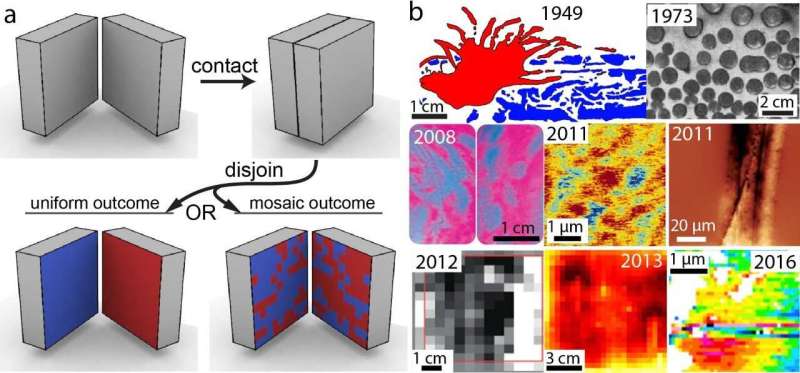80-year-old mystery in static electricity finally solved

Historically, contact electrification (CE) was humanity's first and only source of electricity up until around the 18th century, yet its true nature is still elusive. Today it is considered a core component of technologies such as laser printers, LCD production processes, electrostatic painting, and separation of plastics for recycling as well as a major industrial hazard (damage to electronic systems, explosions in coal mines, fires in chemical plants, etc.) due to electrostatic discharges (ESD) accompanying CE. In a vacuum, ESDs of a simple adhesive tape are so powerful that they generate enough X-rays to take an X-ray image of a finger.
For the longest time, it was assumed that two contacting/sliding materials are charging oppositely and uniformly. In the 1940s though it was observed that each of the separated surfaces is carrying both, (+) and (-) charges, after CE. The creation of so-called charge mosaics was attributed to the irreproducibility of experiments, inherent inhomogeneities of contacting materials, or a general "stochastic nature" of CE.
A research team, led by Professor Bartosz A. Grzybowski (Department of Chemistry) from the Center for Soft and Living Matter, within the Institute for Basic Science (IBS) at UNIST has investigated the possible sources of charge mosaics for over a decade. Published online and to be included in the October 2022 issue of Nature Physics, this study is expected to help control the potentially harmful electrostatic discharges.
"In our 2011 Science paper, we showed sub-micrometer-scale charge non-uniformity of unknown origin. At that time, our hypothesis was to attribute these (+/-) mosaics to the transfer of microscopic patches of materials between the surfaces being separated. However, over many years of work on the problem, this and related models were simply not holding up, as it was gradually becoming unclear to us (and many other colleagues with whom we discussed) how these microscopic patches can explain even millimeter-scale regions of opposite polarity coexisting on the same surface. Nonetheless, we and the community had no better answer why the (+/-) mosaics are seen at all and over so many length scales," says Professor Grzybowski.
In the paper published recently in Nature Physics, the group of Professor Grzybowski shows that charge mosaics are a direct consequence of ESD. The experiments demonstrate that between delaminating materials the sequences of "sparks" are created and they are responsible for forming the (+/-) charge distributions that are symmetrical on both materials.
"You might think that a discharge can only bring charges to zero, but it actually can locally invert them. It is connected with the fact that it is much easier to ignite the 'spark' than to extinguish it," says Dr. Yaroslav Sobolev, the lead author of the paper. "Even when the charges are reduced to zero, the spark keeps going powered by the field of adjacent regions untouched by this spark."
The proposed theory explains why charge mosaics were seen on many different materials, including sheets of paper, rubbing balloons, steel balls rolling on Teflon surfaces, or polymers detached from the same or other polymers. It also hints at the origin of crackling noise when you peel off a sticky tape—it might be a manifestation of the plasma discharges plucking the tape like a guitar string. Presented research should help control the potentially harmful electrostatic discharges and bring us closer to true understanding of the nature of contact electrification, noted the research team.
H. T. Baytekina Et al, The Mosaic of Surface Charge in Contact Electrification, Science (2011). DOI: 10.1126/science.120151
Journal information: Nature Physics , Science
Provided by Ulsan National Institute of Science and Technology
No comments:
Post a Comment